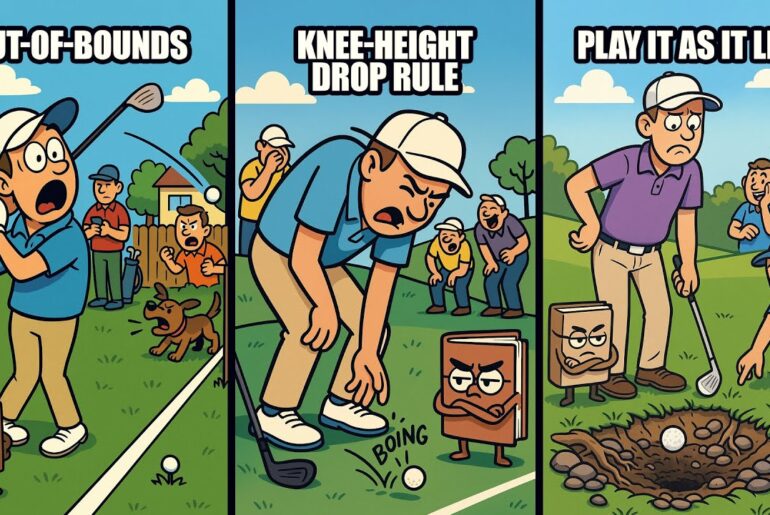If you’ve ever heard golfers say “I’m a 12” or “he’s a 5 handicap” and had no idea what that meant, this video is for you. The golf handicap system sounds complicated, but it’s actually one of the coolest parts of the game—it’s what lets beginners, weekend players, and low-handicappers all compete fairly.
In this video, I break down golf handicaps in simple terms: what a handicap is, how it’s calculated, what Course Rating and Slope mean, the difference between Handicap Index and Course Handicap, how to post scores, what “net vs gross” actually is, and why things like sandbagging and vanity handicaps matter.
By the end, you’ll know how to get a handicap, how strokes are given out on the scorecard, and how to use your handicap to play fair matches with friends and track your improvement over time—without needing a math degree.
#golfhandicap #WorldHandicapSystem #GolfForBeginners #GolfExplained #GolfScoring #GHIN
If you’ve ever heard golfers talking about their handicap and wondered what they meant, you’re not alone. The golf handicap system can seem confusing at first, but it’s actually one of the coolest things about golf. It’s what allows players of different skill levels to compete fairly against each other. Something that doesn’t really exist in most other sports. In this video, I’ll explain everything about golf handicaps in a way that’s easy to understand. Whether you’re just starting out or you’ve been playing for years, understanding handicaps will help you track your progress, compete with friends, and enjoy the game more. Let’s start with the most basic question. What is a handicap? A handicap is a number that represents your average playing ability. It’s basically a way to measure how good you are at golf compared to a scratch golfer, someone who typically shoots par. What makes a handicap useful is that it levels the playing field. If you’re a 20 handicap and your friend is a 10 handicap, you would get 10 extra strokes in a match. This means you can compete fairly even though you’re at different skill levels. The handicap system was developed over 100 years ago to make golf more enjoyable and competitive for players of all abilities. Before handicaps, only players of similar skill levels could have competitive matches. Your handicap is expressed as a number like 15.4 or 8.2. The higher the number, the more strokes you typically shoot over par. A scratch golfer has a zero handicap, meaning they typically shoot around par. Professional golfers often have plus handicaps, like plus4, meaning they typically shoot under par. How is a handicap calculated? Your handicap is calculated using your best recent scores adjusted for the difficulty of the courses you played. It’s not just a simple average of all your scores. The system is designed to reflect your potential, not your average. What makes the calculation smart is that it uses your best scores rather than all your scores. Specifically, it takes your best eight scores out of your most recent 20 rounds, which means your handicap represents what you’re capable of shooting on a good day, not what you shoot on a bad day. The USGAA, United States Golf Association, and other golf organizations worldwide maintain the World Handicap System, which was introduced in 2020 to create one unified system globally. The calculation also adjusts for course difficulty using two numbers. Course rating, what a scratch golfer would typically shoot, and slope rating, how much harder the course is for bogey golfers compared to scratch golfers. This means your handicap is portable. You can use it at any course. Course rating and slope rating. Course rating and slope rating are two numbers that measure how difficult a golf course is. Understanding these helps you understand how your handicap works. Course rating is the score a scratch golfer zero handicap would be expected to shoot on that course. For example, a par 72 course might have a course rating of 71.5, meaning it’s slightly easier than par, or 73.2, meaning it’s slightly harder than par. Slope rating measures how much more difficult the course is for a bogey golfer, someone who typically shoots 18 over par, compared to a scratch golfer. Slope ratings range from 55 to 155 with 113 being average. A higher slope rating means the course is relatively harder for higher handicap players. These ratings are determined by trained course raiders who evaluate factors like length, obstacles, green difficulty, and more. Every set of T’s on every course has its own course rating and slope rating. Understanding these numbers helps explain why your score might affect your handicap differently depending on which course you play. Shooting 95 on a difficult course, high slope rating, is more impressive than shooting 95 on an easy course. Handicap index versus course. Your handicap index and your course handicap are two different numbers, and understanding the difference is important. Your handicap index is your official handicap. The number that represents your ability and stays the same regardless of which course you play. This is the number you’ll see on your GHIN app or handicap card. Your course handicap is how many extra swings you get today from the TE’s you play. The course posts a chart or the app tells you the number. It’s calculated by taking your handicap index and adjusting it based on that course’s slope rating and course rating. For example, if your handicap index is 15.0, your course handicap might be 17 on a difficult course, high slope rating, or 13 on an easier course, low slope rating. This ensures fair competition regardless of which course you’re playing. Most courses have a chart near the first T or in the pro shop that shows you what your course handicap is based on your handicap index. You can also use the GHIN app to calculate it instantly. How to get a handicap? Getting an official handicap is easier than you might think. You need to join a golf club or association that’s affiliated with a handicap service like GH, Golf Handicap and Information Network. What makes getting a handicap worthwhile is that it opens up opportunities to play in tournaments, compete with friends fairly, and track your improvement over time. Many courses also require a handicap to play in member events or certain tea times. To establish a handicap, you need to post scores from at least 54 holes, three 18hole rounds, or six 9-hole rounds. Once you have enough scores, the system calculates your initial handicap index. The cost is typically $25 to $50 per year depending on your club or association. Many golf courses offer handicap services as part of membership, or you can join online through services like GHIN. Once you have a handicap, you’re required to post every score you play under the rules of golf. Whether it’s a tournament round, casual round, or even a solo practice round. This keeps your handicap accurate and up to-date. Posting scores. Posting your scores is how you maintain an accurate handicap. Every time you play around under the rules of golf, you should post your score within 24 hours. What makes posting important is that your handicap only works if it’s kept current. If you only post your good scores, your handicap will be artificially low, called sandbagging. If you only post bad scores, it will be artificially high, called vanity handicapping. You can post scores through the GHIN app, your club’s computer system, or online at ghin.com. You’ll need to enter your gross score, actual strokes taken, the course you played, which TE’s you played from, and the date. The system automatically adjusts your score if you don’t finish a hole or if you pick up. There’s a maximum score you can post on any hole, which is net double bogey, par plus two, plus any handicap strokes you get on that hole. Professional golfers don’t have official handicaps because they play for money, which disqualifies them from the amateur handicap system. However, many pros maintain unofficial handicaps for fun, and they’re typically in the plus4 to plus six range. Net score versus gross score. Understanding the difference between net and gross scores is essential for playing in handicap competitions. Your gross score is your actual total strokes for the round, the real number you shot without any adjustments. If you took 92 strokes to complete 18 holes, your gross score is 92. Your net score is your gross score minus your course handicap. If you shot 92 with an 18 course handicap, your net score is 74. This is the score used to determine winners in most amateur tournaments. What makes this system fair is that it allows players of all skill levels to compete. A five handicap shooting 77 net 72 can compete against a 20 handicap shooting 92 net 8272. In tournaments, prizes are often awarded for both gross and net scores. The gross winner is the player who shot the lowest actual score. The net winner is the player with the lowest score after handicap adjustments. This gives everyone a chance to win. Stroke allocation. Stroke allocation determines which holes you get your handicap strokes on. Not all holes are treated equally. You get strokes on the hardest holes first. What makes stroke allocation important is that it ensures fairness in match play. Each hole on a golf course is ranked from 1 to 18 based on difficulty with one being the hardest and 18 being the easiest. If you’re getting 10 strokes in a match, you get one stroke on each of the holes ranked 1 through 10. If you’re getting 18 strokes, you get one stroke on every hole. If you’re getting 27 strokes, you get one stroke on every hole plus a second stroke on the nine hardest holes. The stroke allocation is shown on the scorecard, usually in a column labeled HCP or handicap. This ranking is determined by the course based on factors like length, hazards, and scoring difficulty. In stroke play tournaments, you simply subtract your course handicap from your gross score. But in match play, the stroke allocation determines which holes you get strokes on, which can be strategically important. Handicap adjustments. Your handicap isn’t fixed. It changes as you post new scores. Understanding how and when it changes helps you track your improvement. What makes the system responsive is that your handicap updates after every score you post. If you shoot a great round, your handicap will go down. If you shoot a poor round, it might go up slightly, though good scores affect your handicap more than bad scores. The system uses your best eight out of 20 scores, so one bad round won’t dramatically increase your handicap. However, consistently good scores will lower it quickly. This is designed to reflect your current ability and potential. There are also exceptional score reductions built into the system. If you shoot significantly better than your handicap, typically seven plus strokes better, your handicap may be reduced by more than usual to prevent sandbagging. Your handicap can also be adjusted by your handicap committee if they believe it doesn’t reflect your ability. This is rare, but can happen if someone is consistently shooting much better than their handicap suggests. Maximum handicap. The maximum handicap index is 54.0 for both men and women. This represents a player who typically shoots about 54 strokes over par on an average course. What makes having a maximum important is that it keeps the system manageable and ensures that handicaps remain meaningful. A player with a 54 handicap on a par 72 course would typically shoot around 126. For beginners, it’s common to start with a high handicap. There’s no shame in this. Everyone starts somewhere, and the handicap system is designed to accommodate players of all skill levels. As you improve, your handicap will naturally come down. Many golfers set goals like break 100 or get to a singledigit handicap. These milestones represent significant achievements in your golf journey. The beauty of the handicap system is that it allows you to compete and have fun regardless of your skill level. A 30 handicap can have just as competitive and enjoyable a match as a five handicap. Sandbagging and vanity handicaps. Sandbagging is when someone intentionally keeps their handicap higher than their actual ability to gain an unfair advantage in competitions. A vanity handicap is when someone keeps their handicap lower than their actual ability because they’re embarrassed by a higher number. What makes sandbagging unethical is that it violates the spirit of fair competition. Someone who sandbags might post only their bad scores or not post scores at all, keeping their handicap artificially high so they get more strokes in tournaments. The handicap system has safeguards against sandbagging, including exceptional score reductions and handicap committees that can review suspicious patterns. Most golf clubs take sandbagging seriously and may penalize or ban players who do it. Vanity handicapping hurts only yourself. If your handicap is lower than your actual ability, you’ll get fewer strokes than you deserve in competitions, making it harder to compete fairly. The best approach is to post all your scores honestly and let the system work as designed. Your handicap is just a number that helps you compete fairly. It’s not a measure of your worth as a person or golfer. Playing conditions calculation PCC is an automatic adjustment that accounts for unusual playing conditions on a given day. What makes PCC important is that it ensures fairness when conditions are significantly different from normal. If it’s extremely windy, raining, or the course is playing unusually difficult, the PCC might adjust everyone’s scores slightly. The system looks at all scores posted from a course on a given day and compares them to expected scores. If scores are significantly higher or lower than expected, a PCC adjustment of -1, 0, or positive 1, rarely positive2 or neg -2, is applied. This adjustment happens automatically and is applied to your score before it’s used in your handicap calculation. You’ll see the PCC listed when you view your posted scores in the GHIN app. For example, if you shot 88 on a day when the PCC was plus one, your score would be adjusted to 87 for handicap purposes, recognizing that conditions were more difficult than normal. Low handicap index. Your low handicap index is the lowest handicap index you’ve achieved in the past 12 months. This number is tracked and displayed alongside your current handicap index. What makes the low handicap index useful is that it provides context for your current handicap. If your current handicap is 12.5 and your low handicap index is 10.2, it shows you’ve been playing better recently and might be trending upward. The low handicap index is also used in some tournament formats to prevent players from entering with handicaps that are significantly higher than their demonstrated ability. This feature was added to the world handicap system in a 2020 as another safeguard against sandbagging and to provide more transparency in the handicap system. If you’re working to improve your game, watching your low handicap index go down over time is a great way to track your progress and celebrate your improvement. So, there you have it. Golf handicaps explained. Remember, the handicap system is one of the things that makes golf special. It’s the only major sport where players of vastly different abilities can compete fairly and have fun together. Don’t be intimidated by the math and calculations. The system does all the work for you. All you need to do is post your scores honestly and let the system calculate your handicap. Whether you’re a five handicap or a 25 handicap, the system ensures you can compete fairly and track your improvement over time. If you don’t have a handicap yet, consider getting one. It opens up opportunities to play in tournaments, compete with friends, and gives you a concrete way to measure your progress. Hit that like button if this helped you understand golf handicaps better.








14 Comments
if ur a 9 handicap, shot an 82. subtract by 9 and ur a net 2 handicapper
Does this also allow woman and men to play together fairly or ?
You got it backwards with the sandbagging and vanity handicaping.
Only posting bad scores and artificially having high handicap is sandbagging.
Only posting good scores is vanity handicapping.
Got sandbagging and vanity the wrong way round. Sandbagging is cheating. Vanity … well, take their money.
These AI videos make me sad. How is this person teaching us about handicaps and get so many things wrong
I am 11 years old and cant follow videos over 3 minutes 🙁
Whenever I am asked what my handicap was, I said that it was my swing and my clubs
Wrong … vanity handicap is for people who only put in their good scores , sandbagging is for people who put in their bad scores only
Wrong , hole handicap rating is determined by what people score on the different holes , example , if hole 5 is causing mostly double bogeys then it will be a harder ranked hole then say hole 6 where most golfers are getting pars on when that course is played
Personally your handicap should be based on your best ever score. If you beat your personal best and win because the other player didn’t beat his personal best, that’s fair.
Its the worst system ever it harder to come down than go out in Handicap.
You can’t post a score playing by yourself or as said, a casual practice round.
I read in his prime Tiger was playing to a plus 8
Where I come from, only posting bad scores is sandbagging and only posting good scores is vanity handicapping.
And, PGA player’s handicaps are more in the +8 to +12 range!!
The part that has always irked me is the vast difference in fairways. Good courses have nice half in grass, most I play here in Canada that are small courses have grass in the so-called fairway that is probably one to two inches deep, more like the rough on good courses with very high members costs.